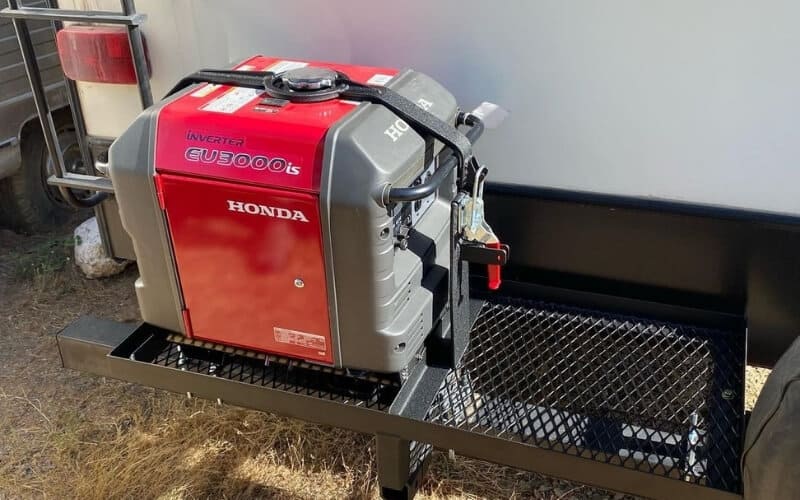The only problem with full-time RV living is that it can sometimes be hard to navigate tighter city streets or just run out quickly for that gallon of milk you forgot at the store.
When I first moved to Austin in my old Tioga RV, we essentially had to use our RV as a commuter vehicle for the first two months.
I would never recommend this course of action and I’d like to do anything in my power to help you avoid such a scenario.
And that’s exactly why I’d recommend towing a vehicle behind your rig using the appropriate set of RV tow bars.
This gives you the flexibility to park your RV and create a “basecamp” at your new destination.
From there, it will be much easier to disconnect your smaller vehicle to explore the area, visit the grocery store, or go out to visit a new restaurant as needed.
But not all tow bars for RVs are rated for a universal fit with all vehicles. And the unfortunate reality is that there aren’t a ton of vehicles out there that can be towed behind an RV.
While that’s not meant to scare you away from doing so, I hope it does highlight the importance of making sure your RV and towed vehicle are compatible before you make an investment into the right set of motorhome tow bars.
Luckily for you, helping you ensure the compatibility of everything you need to tow a vehicle behind your RV is going to be one of our major focus points today.
Oh, and we’re also going to review a few excellent RV tow bars to help you select the right design for your setup.
6 Best RV Tow Bar Reviews 2023
There’s more that goes into an RV car tow bars design than simply making sure it can handle the appropriate weight capacity.
So make sure you note what we specifically liked (and didn’t like) about each of these RV tow bars.
This will help you narrow your options down to two or three models before you read carefully through our Buying Guide!
Here are our top 6 picks for the best RV tow bars for flat towing a vehicle behind your RV or motorhome.
1. Best Overall RV Tow Bar: Roadmaster 422 All-Terrain Blackhawk Tow bar
Our top choice for the best overall RV tow bar is the Roadmaster 422 Blackhawk 2 All-Terrain Tow Bar because it offers a whopping 10,000-pound towing capacity and it easily mounts in the existing tow hitch on the back of your RV.
This towing capacity makes it an excellent choice for towing trucks, Hummers, and other large vehicles behind your rig.
In spite of its size, this tow bar can easily be connected or disconnected by one person.
It also features Roadmaster’s patented Freedom Latch technology that helps to prevent the bars from binding when making tighter turns.
On the motorhome end of the operation, the tow bar’s telescoping, independently-adjustable inner arms make it super easy to maneuver into position.
And they simply lock in place with a pin and then the arms will automatically center themselves as you begin to drive.
At the towed vehicle side, a vehicle-specific base plate will allow you to quickly connect or disconnect these tow bars in seconds.
With the right base plate, you’ll also be able to attach a variety of towing-related Roadmaster accessories.
When the tow bars are moving from side-to-side as you drive, the self-lubricating nylon bushings will eliminate any friction that typically occurs between the inner and outer arms.
This facilitates a smoother operation and differs from other tow bars that feature steel-on-steel designs.
These tow bars also come with channel guides on the arms. These guides keep the safety cables and power cord in place while you drive and they also protect those components from dragging on the ground below your bars.
This eliminates a common problem with many towed vehicles and also gives your entire setup a cleaner, more organized look.
These tow bars mount directly into a standard two-inch hitch receiver and they feature a full-length steel crossbar between the vehicle-specific base plates.
This crossbar provides extra support and makes the overall towing operation of these bars much safer.
Things We Like
Things We Don’t Like
2. Best For Width Adjustments: CURT 19745 5,000 lbsAdjustable RV tow bar
If you’re looking for a set of RV tow bars with excellent width adjustment, check out the Curt 19745 Adjustable RV tow bars.
These bars are one of the more affordable rv car tow bar options on our list and they still offer a maximum towing capacity up to 5,000 pounds.
The width of the base plates on the towed vehicle end of this setup can be adjusted from 26 to 41 inches wide.
It also works with a standard two-inch coupler, but please note that this means you will need a two-inch hitch ball already installed on the back of your RV to attach these tow bars.
The brackets on the towed vehicle side of the operation bolt directly to your vehicle’s frame.
The manufacturer recommends attaching that side of the tow bars before coupling it to the two-inch hitch ball on the back of your RV.
The tow bars themselves extend to a maximum length of 31.25 inches behind your RV.
The two-inch coupler on the motorhome side of these tow bars features heavy-duty steel construction and can be locked in place with a pin or Master Lock.
These tow bars also come with all the required mounting hardware to install them out-of-the-box.
They are also backed by a limited lifetime warranty. This limited last for the first year on both the tow bar’s finish and the parts.
And all of the steel components include a gloss black powder-coated finish to provide extra corrosion resistance.
Things We Like
Things We Don’t Like
3. Best Budget-Friendly Tow Bars: Hiltex 20046 Universal Tow Bar With Safety Chains
If you only tow smaller vehicles behind your RV and you’re searching for tow bars that won’t break your budget, you can’t beat the Hiltex 20046 Adjustable Universal Tow Bars.
These bars offer maximum towing capacity and they are easily the most affordable design on our list.
One thing I really like about these tow bars is that they come with 30-inch safety chains included.
This allows you to back up your work and eliminates the potential of your trailer bouncing off the hitch ball and careening down the highway untethered.
And as someone who has dragged a trailer down a busy highway by the safety chains before, I can tell you that I sure am glad the trailer remained attached to my RV.
I can’t imagine what might’ve happened if I hadn’t had (or used) those safety chains.
The coupler at the front of these bars fits a standard two-inch hitch ball and the width of the bars can be adjusted from 24 to 41 inches wide.
This allows these bars to fit a wide variety of towed vehicle frames.
The construction of the bars themselves features hardened, heat-treated steel for durable, strong performance.
And when you’re not using them, these bars require the least amount of storage space of all the models on our list.
Another feature I like about these tow bars is that they can easily be connected or disconnected from both your RV or towed vehicle.
The mounting brackets on the towed vehicle side can be set in place with two pull pins and the coupler on the RV side simply sets and latches onto a two-inch hitch ball.
Things We Like
Things We Don’t Like
4. Largest Hook-Up Radius: Roadmaster 520 Falcon 2 Mounted RV Tow Bar
If you’re looking for a set of RV tow bars that offer the largest hook-up radius of any product in the industry, check out the Roadmaster 520 Falcon 2 Mounted Tow Bars.
This tow bar set is the little brother to the Blackhawk 2 tow bars that were our choice for the best overall tow bars on the market.
These tow bars still feature a hefty towing capacity of 6,000 pounds and they include many of the same features that make the Blackhawk 2 such a reliable and attractive option.
And as the subheading suggests, they offer the largest hook-up radius in the industry, which means you won’t have to waste time lining up your towed vehicle perfectly.
These bars slide directly into the standard two-inch hitch receiver on the back of most modern RVs.
And then it pins in place and the telescoping, independently adjustable inner arms will automatically center themselves when you begin to drive away.
The base plates that attach to your towed vehicle are connected by a steel crossbar that provides reinforced strength and support.
While you’ll need to make sure the base plate you choose is compatible with your specific vehicle, it’s self-supporting you can easily connect and disconnect it in seconds.
The solid stainless steel inner arms on these crossbars are durable and require very little maintenance.
They are also resistant to corrosion and damage from other road debris.
And the self-lubricating nylon bushings ensure a smoother operation when compared to other tow bars that feature steel-on-steel construction.
In addition, all of the steel elements on these tow bars are finished with a high-tech powder-coat to improve their overall durability.
This coating also further increases the tow bar’s corrosion resistance and gives the entire package a smooth, polished look.
Things We Like
Things We Don’t Like
5. Best Foldaway Tow Bar: Blue Ox Alpha BX7365 RV Tow Bar
If you want a set of tow bars that can remain on your vehicle whether you’re using them or not, we suggest the Blue Ox BX7365 Alpha Tow Bars.
These bars can fold up and remain mounted to your RV’s hitch receiver when you’re not using them, which is a great feature if you don’t always tow a vehicle every time you travel in your RV.
These tow bars do boast a solid maximum towing capacity of 6,500 pounds, but it also comes with safety cables rated for weights up to 10,000 pounds.
Rubber boots on the arms protect the components from water, dirt, and other road grime that comes with the territory of towing a vehicle behind your RV.
They are designed to fit a standard two-inch hitch receiver and the motorhome side of the operation locks in place with a large locking pin.
The towed vehicle end of the bars includes non-binding latch mechanisms that help to provide smoother towing around tighter corners.
The arms feature dependable steel construction and these bars include off-set triple lugs that further reduce binding and help to improve the alignment of towing forces behind your RV.
Plus, the width of the these bars can be adjusted from 16 to 38 inches, depending on the size of your towed vehicle.
At 47 pounds, these are also a pretty lightweight set of RV tow bars, which makes them easier to move around when you do need to disconnect from your RV.
And the easy-release locking handles on both bars make connecting and disconnecting a breeze.
Things We Like
Things We Don’t Like
6. Best Towing Capacity Runner Up: Roadmaster 576 MotoRhome Mounted Tow Bar
Aside from the Blackhawk 2 (which got our vote for the Best Overall RV Tow Bars), you’ll be hard-pressed to find a set of bars with better towing capacity than the Roadmaster 576 All Terrain Tow Bars.
These Heavy Duty RV Tow Bar are rated for a maximum capacity of 8,000 pounds, which makes them great for towing larger vehicles.
These bars fit into a standard two-inch hitch receiver and lock into place using a pull pin.
At the towed vehicle end, one person can easily connect or disconnect the base plates to the frame of your specific vehicle.
But as is the case with all Roadmaster tow bars, you’ll need to make sure you get the appropriate vehicle-specific base plate to ensure compatibility with your vehicle.
That being said, this is one of the few tow bars on the market that features a steel crossbar connecting the base plates.
This crossbar provides added strength and support to the base plates, and it is one of the biggest reasons why Roadmaster’s tow bars have some of the highest towing capacities on the market.
And speaking of industry-leading features, these tow bars also allow for the largest hook-up radius in the industry.
This means that you’ll be able to connect your towed vehicle quickly, even if you’re not able to line it up perfectly with the back of your RV.
You also won’t have to worry about the alignment of your towed vehicle being off because these tow bars feature telescoping, independently-adjustable inner arms.
This means that your vehicle will automatically center behind your rig when you start towing it.
Finally, the self-lubricating polyurethane bushings on the arms of these bars provide a smoother, non-binding towing experience.
They also eliminate the friction between the inner and outer arms of the tow bars.
This friction is what often causes binding and jerky towing with other bars that feature steel-on-steel construction.
Things We Like
Things We Don’t Like
How To Select The Best RV Tow Bar
So do you have those two or three options in mind now? If not, go quickly back through the reviews above.
And now that you have some idea of the best RV tow bars for your setup, here’s what you should consider more carefully in order to select the one set of tow bars that are best suited for your needs.

Towing Capacity
The main factor you’ll need to address is to make sure the tow bars you buy can handle the weight of your towed vehicle.
So start by consulting that small sticker on your towed vehicle to find its gross vehicle weight rating (GVWR). This sticker is usually located on the frame inside of the driver’s side door.
If you can’t find your vehicle’s GVWR there, you can always check the owner’s manual or call the manufacturer directly.
But as a rule-of-thumb, we recommend adding a minimum of 500 to 1,000 pounds to your vehicle’s GVWR. Then search for tow bars rated at or above that capacity.
You should never choose tow bars that are at or within 100 pounds of your vehicle’s GVWR.
That’s just tempting fate and it eliminates the option for you to leave small tools or accessories in your towed vehicle while you’re on the move.
Vehicle Compatibility
It should be noted (before we go any further) that not all vehicles are capable of being towed behind an RV.
In general, you’ll need a front-wheel-drive vehicle with a manual transmission or a four-wheel-drive vehicle with a manual transfer case in order to tow it behind your RV using the dinghy towing method.
In rare cases, some front-wheel-drive vehicles with automatic transmissions can be flat-towable.
Dinghy towing is the most common method for towing a vehicle behind your RV and it’s also referred to as four-down towing, flat towing, or recreational towing.
This means that all four tires of your towed vehicle remain on the road while you’re towing.
And while there are other methods for towing a vehicle behind your RV, all of the RV tow bars on our list are designed for dinghy towing.
Mounting
This can really be the crux of ensuring your tow bars will work with your RV and towed vehicle. Some vehicles already have mounting brackets on the frame.
These are usually located somewhere underneath the front bumper. And if your vehicle already has them, you’re getting off on the right foot.
If it doesn’t, you’ll probably need to weld or bolt brackets onto the frame or find a set of tow bars that are designed to be bolted directly to the front of your vehicle’s frame.
These brackets will be the connection points for the arms of your tow bars.
So, it also makes sense to note the distance between these brackets while you’re already lying underneath your vehicle.
This distance will need to match the width between the base plates or connector arms on the tow bars you choose.
This is why some tow bars have adjustable arms so that they can fit with a variety of towed vehicles.
But if you opt for tow bars with fixed base plates or connector arms, you’ll need to make sure their width matches the distance between the brackets on your vehicle.
On the motorhome side of the operation, you’ll need to make sure your tow bars are compatible with the diameter of your hitch receiver or hitch ball.
The standard hitch receiver is two inches in diameter, but not all RVs are outfitted with a standard setup.
If you already have a hitch and ball installed in the receiver on the back of your RV, your best bet is probably to opt for a more affordable set of tow bars with a coupler at the motorhome end.
But the only downside of these types of tow bars is that they usually have a lower towing capacity.
If you don’t have a hitch ball already installed and just have an open hitch receiver on the back of your RV, then you’ll probably opt for tow bars that slide directly into your hitch receiver.
But again, you’ll need to make sure that the diameter of the mounting bar on the tow bars matches the diameter of your hitch receiver.
This, however, is usually the preferred setup if you’re towing a larger truck or SUV.
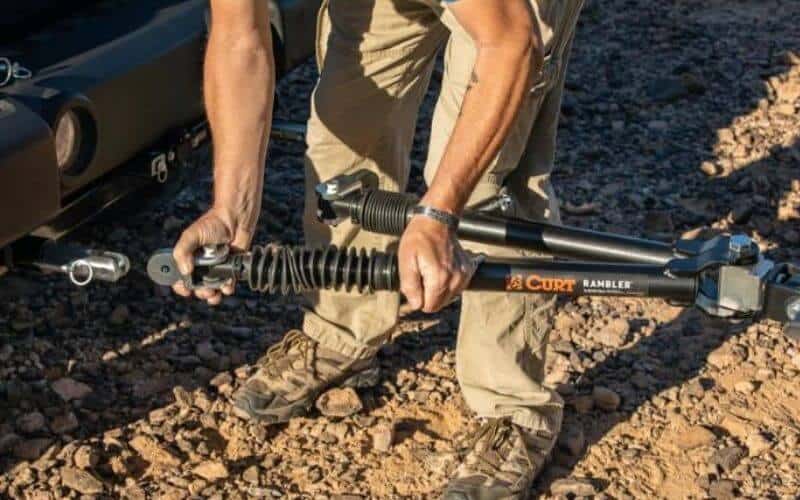
Wiring Connections
Unfortunately, not many rv car tow bar come with wiring connections.
But these are essential so that you can hook your RV to your towed vehicle and operate turn signals, brake lights, and emergency flashers. Otherwise, you’ll be driving dangerously and illegally.
So if you can find a set of tow bars that comes with the compatible wiring connections, that’s the proverbial icing-on-the-cake.
Otherwise, you’ll need to carefully consult the tow bar manufacturer to make sure you choose wiring connections that are compatible with your RV, tow bars, and towed vehicle.
Safety Cables
If you opt for a set of RV tow bars that mount directly into the two-inch hitch receiver on the back of your RV, safety cables probably won’t be necessary.
But if you get a set of bars with a standard two-inch coupler that’s designed to secure to a hitch ball, safety cables are a must.
These cables act as your fail-safe if something goes awry with the hitch coupler.
Without them, your vehicle can bounce off the hitch coupler and proceed to take any direction it desires on the road. And you can only imagine the type of damage this can cause.
While vehicles bouncing off a hitch coupler isn’t common (if secured properly), there’s absolutely no reason why you shouldn’t secure safety cables as a backup if you’re using tow bars with a hitch coupler.
Additional Features
After you check off the basic requirements for a tow bar that suits your needs, then you get to look into additional features.
Some examples of these features include weatherproof housings, friction-reducing bushings, and easy collapsibility for storage.
The extent to which each of these features is important to you depends on your unique RV lifestyle.
If you frequently connect and disconnect your towed vehicle and don’t want your tow bars sticking out while you’re away, for example, then you might want to identify bars that feature a foldaway design.
But if you always tend to do your RV traveling in rainy or salty environments, then looking for a set of tow bars with a powder-coated finish, weatherproof housing, and other features designed to maximize durability should be your priority.
RV Tow Bar Price
These RV tow bars are available at a wide range of prices. While you can find an extremely budget-friendly model for less than $100, some of the higher-end designs come with price tags in excess of $1,000. But if you’re searching for a quality set of tow bars for flat towing at a reasonable price, we’d recommend identifying choices in the $500 to $800 range.
Of course, making a larger investment is typically going to lead to a more durable set of tow bars, which can be really important if you’re a full-time RVer and you plan to tow your vehicle for a lot of miles every year.
So, What Is The Best Tow Bar For RV?
If you’re looking for the best overall RV tow bars, you’ll be hard-pressed to beat the Roadmaster 422 Blackhawk 2 All-Terrain Tow Bars. These rv car tow bars offer the highest towing capacity of any model on our list (10,000 pounds) and they also offer the largest hook-up radius of any tow bars on the market.
This means you won’t always have to line your towed vehicle up perfectly behind your RV to connect the tow bars.
This saves you time connecting and disconnecting your towed vehicle and you’ll also love the smooth, non-binding operation of these tow bars when you’re navigating tight turns.
But if you’re interested in a set of tow bars that can be adjusted to many different widths, check out the Curt 19745 Adjustable RV Tow Bars. These bars can be set anywhere from 26 to 41 inches apart and they still offer a decent towing capacity up to 5,000 pounds.
This makes them a super affordable option for towing smaller vehicles behind your RV.
And these bars also come with all of the mounting hardware you’ll need to install them upon the arrival of the product.
So this means no need for the purchase of any additional tools or hardware to hook up your vehicle and start driving toward your next RV destination.
Frequently Asked Questions
As with most RV products, picking the right one is only the first step. You need to know how to install and use the product correctly if you’re really going to get a healthy return on your investment.
So we’ll focus on those themes (and a few others) as we answer some of the most frequently asked questions about RV tow bars.
How do these tow bars work?
RV Tow bars work by providing a strong frame for towing a heavy vehicle behind an RV and motorhome. They usually feature an A-frame design because it distributes the weight of your towed vehicle and also makes towing safer.
The A-frame design also serves to minimize vehicle wobbling (sometimes known as ‘fishtailing) at high speeds.
Tow bars typically mount into the receiver hitch or connect to the hitch ball using a coupler. Your towed vehicle is then connected to the other end of the bars using heavy-duty bolts.
Then, wiring is connected from your RV to your towed vehicle so that you can still make the appropriate signals for safe driving.
And if you have to make a sudden stop, tow bars will prevent your towed vehicle from slamming into the back of your RV.
Does towing a car behind your RV put miles on it?
No! Towing a car behind your RV will not add miles to its odometer. If you are dinghy (or four-down) towing, however, the wheels of your towed vehicle will spin and remain in contact with the road.
So this will cause normal wear and tear on your vehicle’s tires and suspension, even if it doesn’t add miles to your odometer.
This means you should always check the tires on your towed vehicle for punctures or flats before disconnecting from your RV and driving away.
Are these RV tow bars safe?
Yes, provided the vehicle being towed is below the bar’s rated towing capacity and all elements are installed and connected properly.
Now that might sound like a lot of ‘ifs’, but tow bars really aren’t that complicated to install.
As long as you follow the manufacturer’s installation instructions carefully, this is the safest way to tow a vehicle behind your RV.
What size tow bar do I need?
The answer to this question will depend on the weight of the vehicle you want to tow.
If you opt for tow bars that connect to a standard two-inch hitch ball, the maximum towing capacity is usually going to be somewhere around 6,000 pounds.
But if you choose a design that mounts right into the two-inch receiver hitch on your rig, you can find capacities up to about 12,000 pounds.
However, there is the possibility of using a large hitch receiver and ball combination.
For example, two-and-5/16ths hitches are rated for vehicles between 6,000 and 30,000 pounds.
And there are also three-inch hitches that are design for super heavy-duty vehicles up to 30,000 pounds.
What’s important when installing RV tow bars?
When installing your new tow bars, please consider the following:
- The legal requirement for this distance is a minimum of 65 millimeters.
- License Plate Obstruction
- Your tow bars must not obstruct the view of your RV’s license plates or your plates must be moved so that trailing vehicles can see them.
Please also keep in mind that the vertical height and horizontal clearance requirements may vary from state-to-state.
So it pays to double-check the mandatory requirements for the states in which you travel most frequently.
Conclusion
Okay, so let’s get towing! As someone with many years of RV experience, my opinion is that the goal should be to drive your RV less as the size of your RV grows.
In other words, bigger rigs are best suited to moving every three to four months and towing a smaller vehicle for more efficient local travel needs.
I’m also personally of the persuasion that it takes at least three months to really get to know a place.
And having a vehicle that can go more places (and do so more economically) is really a great way to fully explore the areas where you park your RV.
But it’s undeniable that the safest way to protect all of your investments when towing a vehicle behind your RV is to pick the best RV tow bars possible!
So we hope that you’ve found all of this information useful and we wish you only the best of luck in all of your future RV travels.

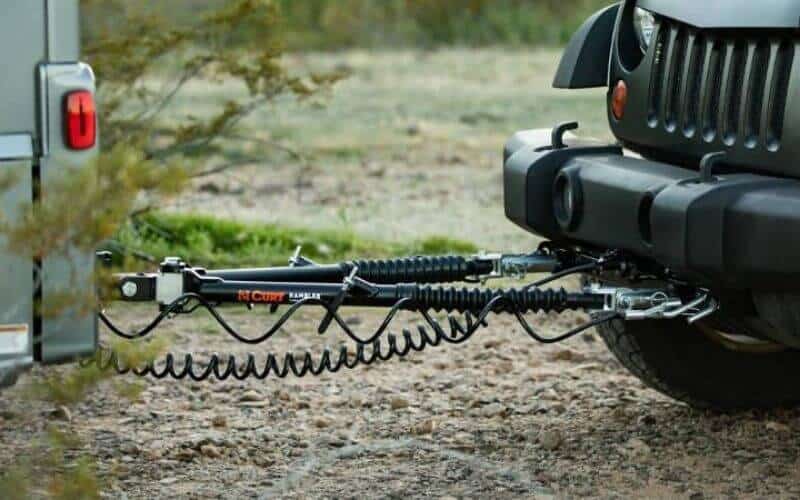



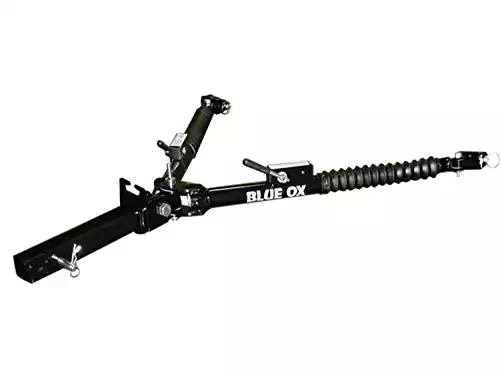
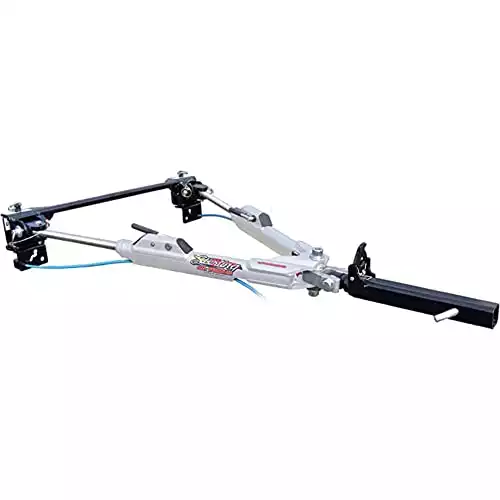

![Best RV for Boondocking in [currentyear] for Off-Grid Travel Trailer Adventures 8 Best Boondocking Travel Trailers](https://www.rvingknowhow.com/wp-content/uploads/2021/10/Best-Boondocking-Travel-Trailers-150x150.jpg)
![The 6 Best Portable Air Conditioners For RVs In [currentyear] 9 Best Portable Air Conditioners For RV](https://www.rvingknowhow.com/wp-content/uploads/2020/06/Best-Portable-Air-Conditioners-For-RV.jpg)

